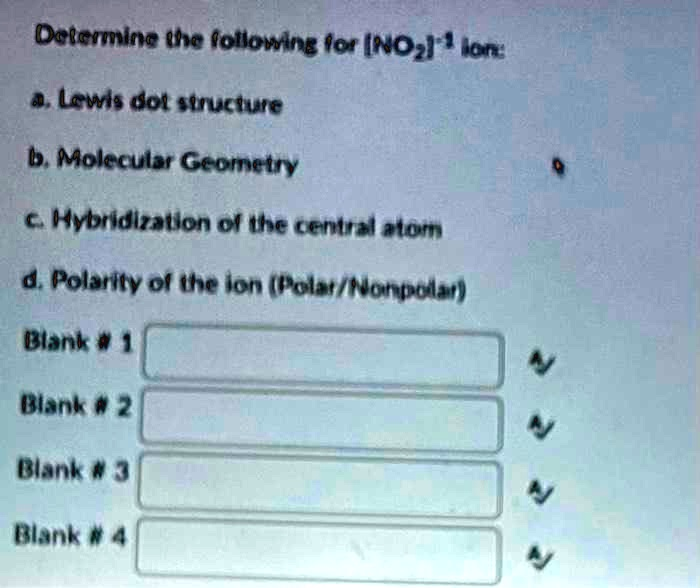Molecular Geometry c. Hybridization of the central atom d. Polarity of the ion (Polar/Nonpolar) Blank # 1 Blank #2 Blank #3 Blank # 4
Determine the following for [NO2]?¹ ion: a. Lewis dot structure b. Molecular Geometry c. Hybridization of the central atom d. Polarity of the ion (Polar/Nonpolar) Blank # 1 Blank #2 Blank #3 Blank # 4

The Correct Answer and Explanation is:
Here are the correct answers for the [NO₂]⁻ ion:
Blank #1 (Lewis dot structure):
O=N−O with a negative charge and one double bond, one single bond, and lone pairs on the oxygen atoms. The negative charge is delocalized due to resonance.
Blank #2 (Molecular Geometry):
Bent (or Angular)
Blank #3 (Hybridization of the central atom):
sp²
Blank #4 (Polarity of the ion):
Polar
Explanation
The [NO₂]⁻ ion is known as the nitrite ion. To determine its properties, we begin with the Lewis dot structure. Nitrogen contributes 5 valence electrons, each oxygen contributes 6, and there is one extra electron due to the negative charge, giving a total of 18 valence electrons.
The structure has nitrogen in the center bonded to two oxygen atoms. One N−O bond is a double bond, and the other is a single bond with a formal negative charge on the singly bonded oxygen. However, due to resonance, the double bond and single bond can switch between the two oxygen atoms, meaning both N−O bonds are equivalent in practice.
The electron domain geometry is based on three regions of electron density around nitrogen (two bonding regions and one lone pair), which results in a trigonal planar electron geometry. However, because of the lone pair on nitrogen, the molecular geometry is bent.
The central nitrogen atom uses sp² hybrid orbitals to accommodate these regions of electron density. Hybridization is sp² because one s orbital and two p orbitals mix to form three equivalent sp² hybrid orbitals.
The molecule is polar due to its asymmetrical shape and the difference in electronegativity between nitrogen and oxygen. Even though the resonance structures make the bonds equivalent, the bent geometry ensures that the dipole moments do not cancel out, resulting in an overall polar ion.
This polarity affects the solubility and reactivity of the nitrite ion in aqueous solutions, making it significant in chemical and biological systems.
